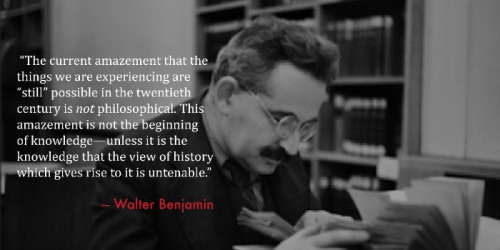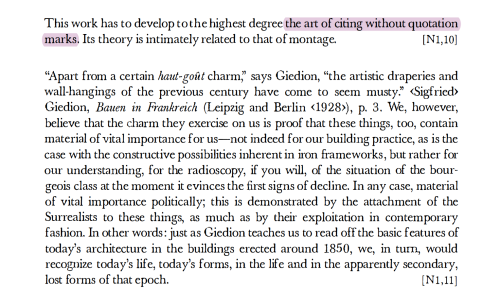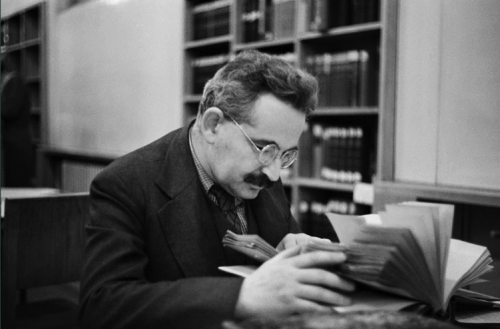#walter benjamin
From a letter to a friend:
What was really interesting was when I went to Vegas. Vegas is conservative middle America, and businessmen, it’s devoted to commodification and manipulation of desire. I’m going back to my notebook, where I started taking a few notes for a mail I was going to send you while I was out there but which I never got round to.
I thought I’d put down a few informal thoughts about my NAB time in Vegas. Partly to give you a sense of what it’s like, partly as process. Also partly because I feel the way to understand a thing is not to view it directly, but as Thomas Browne had it in his posthumously published Christian Morals (1716):
“Besides, many things are known, as some are seen, that is by parallaxis, or at some distance from their true and proper beings; the superficial regard of things having a different aspects from their true and central natures.”
Vegas is so strange. The elements are incredibly simple, almost abstract. There are two monads: the city of Vegas and the Mojave desert around it. The desert is a place of a fierce allegiance and antagonism between the sun - which burns very fiercely in the arid air - and the rock - that strata of organic matter, a result of the permian-triassic megadeath, a graveyard of 96% of all marine species laid down 252 million years ago in the shallow seabeds that covered the area, lithified and compressed by the winds and deep time.
JB Priestley said that as you travel southwest in the united states, you become more aware of geology than of human history. you can see the levels of geological time, and the contours and fluidity of the sierra, moving like waves through vast epochs (which is after all what they are doing).
The Paiute indians communed with the gods in the cosmos, and by the position of the stars, divined to know when the minimal sustenance the desert offered would be available: pine nuts from the pinyon tree, roots, and sagebrush.
And in the centre of this harsh geometric plane, there is a central node, which is Las Vegas - The Meadows.
I stopped there, or rather my writing disintegrated into the usual mess of half-legible notes and arrows &c. that represents a diffusion of thought. But if i had continued more coherently, I would have pointed out that, imagining that plane of the Mojave Desert, with its vivid night sky and cosmic holism, in which is that single point of Las Vegas, which is formed by the intersection of four very basic vectors: money, energy (namely electricity), water, desire. The manipulation of these comprises the four causes of Vegas. There is one further coherent phrase in my notebook:
The single point of connection between these two monads is the Boulder Dam, now more commonly known as the Hoover Dam, across the Colorado River.
It may also be seen as the point of conversion - taking the cosmic system of the desert and canalising it into those four elements out of which Vegas was constructed and through which it is controlled or should i say through which it controls. This is as much the case in its efficient cause as it is in its material cause: The Meadows came into being as a consequence of the vast numbers of workers brought in to create the Boulder Dam. Out of the Great Depression and Roosevelt’s New Deal, was built this Fantasy Land, designed to part people from their hard-earned dollars as efficiently as possible. To my mind the Great Depression is still present in its working. It still designed to appeal more to middle America than any notion of the high roller - all the Middle Eastern gambling takes place in Macau, I think. But what is that appeal? Maybe some people think they will go to Vegas and make it rich, but the whole thing is clearly about fulfilling desire. As such it equally clearly in its commoditised, processed verions of desire-fulfilment it represents an emptiness. I don’t mean to patronise - the obvious extent to which Vegas goes about its business with such pathological determination suggests the people who visit are, to a certain extent, happy with what it has to offer, that they recognise the facade, and that what it gives is a proxy for desire fulfilment in return for cash. It is America’s theme park, to an extent I didn’t really realise - Lauren and her husband live in Lubbock, Texas, and regularly fly to Vegas at the weekend. It astonishes me that anyone would want to do this at all regularly, but people still do. The US ability to enjoy, in all sincerity, the ersatz is impressive really, or at least very un-English. This is different from the ironic enjoyment or awareness of the kitsch in the ersatz. Having said all that, I’m sure you like me have encountered many Americans who have an equally strong desire to consume that dangerous commodity, so auctioned by Old Europe - authenticity.
As for the material causes, the Boulder Dam generates the electricity (much of this is i believe sold to California, which then sells it back to Vegas O_o), and the water from Lake Mead. This water needs chlorinating because it needs constant recycling to irrigate the Meadows with its pleasure fountains and pools. The heavenly mirage of the oasis comes at a huge exertion of energy sucked out of nature. The infernal equivalent in the desert is the dust devil raised out of a compact of convecting desert heat and wind to raise a whirlwind of dust above the ground.
As is well known, I believe, Las Vegas negates the organic diurnal rhythms into a perpetual neon, oxygenated twilight in order to keep people gambling. I’d walk through the casinos listening to DAMN., across the grimy soft carpets, taking in the smell and texture of chlorine, ionized fag smoke, the chill of the aircon, ceilings painted like skies. The same mechanisms Vegas pioneered have since long been used in supermarkets and in all sorts of areas designed to optimise the ability to extract cash. Now many of the physical mechanisms seem quaint, with newer, more sophisticated mechanisms and algorithms sinking into the structures behind society and manipulating desire in ways harder to perceive than the gaudy excess of Vegas. As I say it seems almost innocent. And there is always an advantage to crudely set out versions of the mechanisms that control our lives in more sophisticated and hidden ways.
The architecture is of course, in rather raw sense of the word, incredible. It reminds me of a science-fiction short story, where a doomed planet was forced to emigrate to another, fresher planet, suitable for existence. First they sent the engineers, who perished on landing, in a crash, then they sent the anthropologists, to recreate the cultural landscape - they also perished, and so on. Finally they sent the blue-collar workers, who created a bizarre fantasy world that represented their image of the world they had come from. So Vegas, as you know. Excalibur has knights in armour, kilted Scottish lairds, maids in dirndles, Robin Hood, and Celtic trappings, Paris has the Eiffel Tower jammed in it and quaint 19th century facades, Venice is all hispanic gondaliers and chlorine. (It is interesting that the Trump Hotel is the only hotel where its theme is itself). Behind these frontages are those huge car parks, separate ones for staff and for patrons, themselves the true backdrop of US desire. They’re beginning to have to charge for the use of car parks, one sign among many that Vegas is in decline.
As far as I can tell one area it still continues to do well from is business conferences. I think it’s the largest conference facility in the US. And of course the answer to the question ‘Why Vegas?’ is because business was always the domain of men and so basically it was the place they could go to booze, get laid and gamble. According to a colleague, even comparatively recently (like in the last 20 years) some clients still expected to be taken to brothels. In fact, I don’t know why I’m so naive - I’m sure that still happens.
I know I’ve gone on at length, but this is the backdrop for NAB. It is, to my mind, all non-trivially weird and calculating at the same time. There is, as I say, a nauseating pathology to it all, especially when it comes to the cynicism of the corporate side. The male gaze is totally legitimised there. Men are released from the daily bullshit of having to pretend, and exchange conspiratorial glances and innuendo. That almost tactile male atmosphere a friend mentioned in corporate offices becomes a disgustingly thick fug, and you are treated with bare contempt if you are not the sort of person to enter into it. I do not want to come across as a blowhard puritan, but there is something about the rotten core of male business that gets exposed here. What am I saying, it exposes itself.
When you get to NAB on the first day it’s all still being put up - the chipboard stands will, in 24 hours, be glittering with encrusted media technology. It is all as flimsy and gimcrack as hell of course, like everything else here, including people’s egos.
There was a passage that struck me with great but enigmatic force in Gerhard Scholem’s account of his friendship with Walter Benjamin:
Among the books he [Benjamin] read in connection with this seminar was Daniel Paul Schreber’s Denkwürdigkeiten eines Nervenkranken [Memoirs of a neuropath], which appealed to him far more than Freud’s essay on it. He also induced me to read Schreber’s book, which contained very impressive and pregnant formulations. From a salient passage in this book Benjamin derived the designation “flüchtig hingemachte Männer” [hastily put-up men]. Schreber, who at the height of his paranoia believed for a time that the world had been destroyed by “rays” hostile to him, gave this as an anaswer when it was pointed out to him that the doctors, patients, and employees of the insane asylum obviously existed.
Flüchtig hingemachte Männer. I would like to know what Benjamin so designated by this phrase. It seems to me incredibly useful. So useful, that it’s tempting to use it for every damn person you come across in the office or at an event like this. And yet it means more than just empty or fraudulent. There is of course the notion of a deception, not an individual deception, but structural, organised deception. But there is more than just the notion of the Potemkin Village, designed to assure anyone reviewing the event that all is well. It is a structural deception designed to undermine a sense of reality. It is a sort of power-structure gaslighting, which will imply insanity for anyone who doubts it. With the façades of Vegas, the temporary shanty town of media technology, the trouser-hoisting, proud droit-de-seigneur surveillance of the men,mutually assuring each other of their power and feeble, fragile virility, it was a phrase that continually ocurred to me, with a sort of haunting hypnosis.
And DAMN. went from being something which seemed totally, socially rich and democratic to something that felt incredibly protective. I heard no Kendrick in Las Vegas. I’d put in my headphones and I’d find space to breathe. I remember listening to LUST on the monorail, with its line 'might as well overheat’ and thinking yes, just let go, stop trying to control it, just overheat, let the pain overtake you, let it overcome you, stop trying to control it, allow it to annihilate you - it was also incredibly hot outside of course - and I just felt a sense of tranquility, and of distance from it all. At this point the entire album seemed to ward off the bad spirits of Vegas. It was private, and contained within it the world that I’d seen in San Francisco.
Found the Walter Benjamin quote from Gershom Scholem’s ‘The Story of a Friendship’:
Benjamin’s deep, inner relationship to things he owned – books, works of art, or handcrafted items, often of rustic construction – was evident. For as long as I knew him, even during my last visit with him in Paris, he loved to display such objects, to put them into his visitors’ hands, as he mused over them aloud like a pianist improvising at the keyboard. During the months I am writing about I noticed on his desk a Bavarian blue glazed tile, depicting a three-headed Christ, he told me that its enigmatic design fascinated him. In time he gradually added to his collection various small figurines and pictures, mostly reproductions. Even then a print of Mathias Grünewald’s Isenheim Altarpiece hung on the wall of his study, where it would remain for many years to come. In 1913 as a student he had made a special trip to Colmar to see the original. His notes from those years often refer to the Isenheim panels; he ws overwhelmed by what he called das Ausdruckslose, their quality of expressionlessness. In the twenties he was apt to offer philosophical reflections as he brought forth a toy for his son. Once he brought along from Moscow a silver dagger over which he launched forth with reflections on terror that were only half ironic. In his room in Paris hung a tattoo artist’s large pattern sheet that he had acquired in Copenhagen. He was particularly proud of this item and regarded it on the same plane as children’s drawings and primitive art.
I connect this to Benjamin’s kabbalah of meaning and memory - the way he will locate intensity of memory, emotion and the spiritual, in physical locations and things. This is particularly noticeable in his Berlin reminiscences. They create a personal symbolism that is nevertheless located in the shared physical world.
This has been important for me – understanding this, using physical locations and things to explore emotional spaces, trying to understand its praxis.
Nothing that has ever happened should be regarded as lost for history.
Walter Benjamin
“It is more arduous to honor the memory of anonymous beings than that of the renowned. The construction of history is consecrated to the memory of the nameless.”
Walter Benjamin’s memorial in Portbou, Spain. He died here trying to flee the Nazis.
Post link
“In our writing, opposites that in happier periods fertilized one another have become insoluble antinomies. Thus science and belles-lettres, criticism and production, education and politics, fall apart in disorder. The theater of this literary confusion is the newspaper, its content ‘subject-matter’ which denies itself any other form of organization than that imposed on it by the readers’ impatience. And this impatience is not just that of the politician expecting information, or of the speculator on the lookout for a tip; behind it smolders that of the man on the sidelines who believe he has the right to see his own interests expressed.
The fact that nothing binds the reader more tightly to his paper than this impatient longing for daily nourishment has long been exploited by the publishers, who are constantly opening new columns to his questions, opinions, protests. Hand in hand, therefore, with the indiscriminate assimilation of facts, goes the equally indiscriminate assimilation of readers who are instantly elevated to collaborators. In this, however, a dialectic moment is concealed: the decline of writing in the bourgeois press proves to be the formula for its revival in that of Soviet Russia.
For as writing gains in breadth what it loses in depth, the conventional distinction between author and public, which is upheld by the bourgeois press, begins in the Soviet press to disappear. For the reader is at all times ready to be come a writer, that is, a describer, but also a prescriber. As an expert – even if not on a subject but only on the post he occupies – he gains access to authorship.
Work itself has its turn to speak. And the account it gives of itself is a part of the competence needed to perform it. Literary qualification is founded no longer on specialized but, rather, on polytechnic education, and is thus public property. It is, in a word, the literarization of the conditions of living that masters the otherwise insoluble antinomies, and it is in the theater of the unbridled debasement of the word – the newspaper – that its salvation is being prepared.”
– Walter Benjamin, The Author as Producer, 1934
onlar yarının dünyasını ister istemez yaratmaktadırlar. her adımda geri çekilmek istemeleri ve tutarsızlıkları en güçlü çelişkileri, boşluklarıdır. çünkü yaratmakta oldukları bu dünyanın kendilerini içine almayacağını içgüdüsel olarak bilmektedirler.
christopher caudwell - yanılsama ve gerçeklik
yanlış görebilirsin, yanlış bilebilirsin, hatta yanlış düşünebilirsin ama yanlış hissedemezsin.
ekol frankfurt
bence kötülük, bir tür salaklıktan başka bir şey değil.
brecht - sezuan'ın iyi insanı
sevgisi vasattır, vasatı aranır durur. ama nefreti dahiyanedir. nefreti seni beni herkesi öldürebilecek kadar dahiyanedir.
bukowski - en kısa andır mucize
InArchiveologyCatherine Russell uses the work of Walter Benjamin to explore how the practice of archiveology—the reuse, recycling, appropriation, and borrowing of archival sounds and images by filmmakers—provides ways to imagine the past and the future. Noting how the film archive does not function simply as a place where moving images are preserved, Russell examines a range of films alongside Benjamin’s conceptions of memory, document, excavation, and historiography. She shows how city films such as Nicole Védrès’s Paris 1900 (1947) and Thom Andersen’s Los Angeles Plays Itself (2003) reconstruct notions of urban life and uses Christian Marclay’s The Clock (2010) to draw parallels between critical cinephilia and Benjamin’s theory of the phantasmagoria. Russell also discusses practices of collecting in archiveological film and rereads films by Joseph Cornell and Rania Stephan to explore an archival practice that dislocates and relocates the female image in film. In so doing, she not only shows how Benjamin’s work is as relevant to film theory as ever; she shows how archiveology can awaken artists and audiences to critical forms of history and memory.
https://archive.org/details/archiveology-walter-benjamin-and-archival-film-practices/mode/2up
Post link
The fairy tale, which to this day is the first tutor of children because it was once the first tutor of mankind, secretly lives on in the story. The first true storyteller is, and will continue to be, the teller of fairy tales. Whenever good counsel was at a premium, the fairy tale had it, and where the need was greatest, its aid was nearest. This need was created by myth. The fairy tale tells us of the earliest arrangements that mankind made to shake off the nightmare which myth had placed upon its chest
Post link
Renzo Novatore’s eulogy on Bruno Filippi
Who was he? Where was he going?
Fools! And where have you gone? Where are you going?
He was broken while breaking the chains that you, united in a cowardlyandhateful way in your manifold quality as dangerous lunatics, riveted logically and morally to his twenty year old rebel wrists in order to crushhis Uniqueness,his mystery, because he wasincomprehensibleto you, precisely as the complicated mind of one who feels complete in himself must be. Bruno Filippi hated. But the forces of Hatred did not crush the powers of Love within Him. He immolated himself in a fruitful embrace with death because he madly loved Life. We have the need and the entitlement to say of him that which was said of the D’Annunzian hero: “That the slaves of the marketplace turn around and remember!”
-In the Circle of Life
In Memory of Bruno Filippi
Post link











